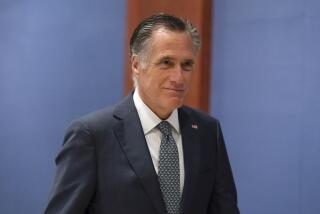Conferees Stall Over Agenda on Measure to Bail Out S
- Share via
WASHINGTON — The congressional conference to prepare a massive savings and loan industry rescue bill bogged down in confusion and acrimony Thursday as House and Senate members disagreed on procedures.
The Senate negotiators, in a surprise move, offered a package deal but were quickly rebuffed by House members, who want to discuss and resolve each issue separately.
The differing approaches reflect the numbers involved: There are just eight Senate conferees, with five handling most of the bill. The House, by contrast, has 94 participants divided into “platoons” dealing with different issues.
The original agenda called for the conferees to spend Thursday dealing with the two biggest issues of the legislation: the proposed tough new financial standards for S&Ls; and whether to include the full cost of the bailout in the federal budget.
Stringent Capital Requirement
After meeting separately earlier Thursday, the key Senate conferees assembled a package proposal calling for tight capital rules and accepting a House provision that would require S&L; owners to furnish $3 of their own cash for every $100 in loans made by the institution.
This indicated their willingness to go beyond the bill that was passed by the Senate--and even to surpass the stricter House version--by forcing the 3% standard into effect immediately on passage of the legislation.
However, the Senate negotiators’ package plan also calls for keeping the financing of the S&L; rescue, estimated at nearly $300 billion over 30 years, off the federal budget through a special bond issue. The bill passed by the House would require the cost of the bailout to be on the budget.
The senators’ willingness to accept a more stringent capital requirement for S&Ls;, as well as to accept the House view of some other issues, did not impress the House members.
House Banking Committee Chairman Henry Gonzalez (D-Tex.), clearly miffed by the senators’ surprise move, called the proposed package “raw and undefined.” Its sudden presentation “is a horrendous injustice to House conferees,” Gonzalez said after the legislators had been wrangling for several hours without resolving a single issue.
“I am deeply disappointed we have wasted so much time when we could have cleared out the capital issue,” Gonzalez said. “For us to be stalled by the Senate conferees . . . is quite unfair.”
The leader of the Senate contingent, Banking Committee Chairman Donald W. Riegle Jr. (D-Mich)., said the Senate proposal included “as many of the key House provisions as we can. In many areas we are very close together.” He expressed hope that the House would consider the Senate plan and respond quickly, enabling the conference to complete its work early next week.
The ranking Republican senator, Jake Garn of Utah, also appealed for a quick response. “We can’t hold the package together that we hammered out with each other unless it is responded to by the House,” he said.
But Gonzalez and his House colleagues were adamant that the conference should continue with its original agenda, dealing with capital standards and the budget financing issue, on a discrete basis, rather than trying for a broad compromise.
The Senate plan “is very vague and undefined,” Gonzalez said. “It is so broad and general it doesn’t contain any real offer we could entertain.”
With S&L; losses continuing to mount at a rate of $500 million to $1 billion a month, the goal of the conference is to send a bill to President Bush before the end of the month. The legislation would provide funds to close hundreds of insolvent thrift institutions and pay off their customers, whose deposits of up to $100,000 are guaranteed by federal insurance.
More to Read
Get the L.A. Times Politics newsletter
Deeply reported insights into legislation, politics and policy from Sacramento, Washington and beyond. In your inbox twice per week.
You may occasionally receive promotional content from the Los Angeles Times.










